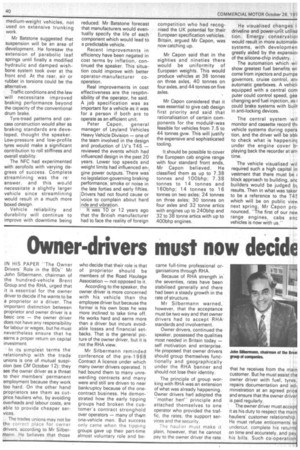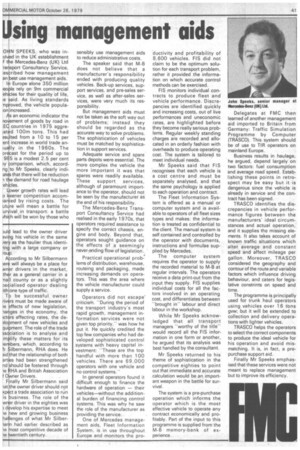Owner-drivers must now decide
Page 42

Page 43

If you've noticed an error in this article please click here to report it so we can fix it.
IN HIS PAPER The Owner Drivers Role in the 80s" Mr John Silbermann, chairman of the hundred-vehicle Brent Group and the RHA, urged that it is essential for the owner driver to decide if he wants to be a proprietor or a driver. The important distinction between proprietor and owner driver is a basic one — the owner driver does not have any responsibility for labour or wages, but he must nevertheless ensure that he earns a proper return on capital investment.
In its simplest terms the relationship with the trade unions is one of mutual suspicion (see CM October 12): they see the owner driver as a threat to their members' permanent employment because they work too hard. On the other hand proprietors see them as cutprice hauliers who, by avoiding overheads and labour costs, are able to provide cheaper services.
The trades unions may not be the correct place for owner drivers, according to Mr Silbermann. He believes that those who decide that their role is that of proprietor should be members of the Road Haulage Association — not opposed to it.
According to the speaker, the owner driver is more concerned with his vehicle than the employee driver but because the former is his own boss he was more inclined to take time off. He works hard and earns more than a driver but incurs avoidable losses and financial setbacks. That is the general picture of the owner driver, but it is not the RHA view.
Mr Silbermann reminded conference of the pre-1968 Contract A licence under which many owner drivers operated. It had bound them to many unrewarding contracts and many were and still are driven to near bankruptcy because of the one contract business. He demonstrated how the early tipping groups had broken the customer's contract stronghold over operators — many of them one-vehicle men. But success only came when the tipping groups gave up their part-time almost voluntary role and be came full-time professional organisations through RHA.
Because of RHA strength in the seventies, rates have been stabilised generally and there had been a steady growth in the rate of structure.
Mr Silbermann warned, however, that the acceptance must be two way and that owner drivers had to accept RHk standards and involvement.
Owner drivers, continued the speaker, possessed the qualities most needed in Britain today — self motivation and enterprise. He proposed that owner drivers should group themselves functionally and geographically under the RHA banner and should not lose their identity.
The principle of group working with RHA was an extension of what was already happening. Owner drivers had adopted the "mother hen"' principle and attached themselves to one operator who provided the traffic, the rates, the support services and the security.
The haulier must make it plain, however, that he cannot pay to the owner driver the rate
that he receives from the main customer. But he must assist the owner driver with fuel, tyres repairs documentation and administration at an agreed price and ensure that the owner drive is paid regularly.
The owner driver must accept it as his duty to respect the main hauliers' customer relationship. He must refuse enticements to undercut, complete his returns on time and accurately, and pay his bills. Such co-operation puld lead to the owner driver vi hg his vehicle in the same iery as the haulier thus identiin with a large company or r0
Abcording to Mr Silbermann ier+ will always be a place for uvri r drivers in the market, th r as a general carrier in a 118 I county or as a slightly De ialised operator dealing ith one type of traffic.
T be successful owner riv rs must be made aware of le effects of new legislation, -ia4ges in the economy, the ictalws affecting rates, the deE.dorent of new vehicles and qui ment. The role of the trade ssqciation is to analyse and mg)lify these matters for its lentibers, which, according to 1r ilbermann, RHA does. He 3id that the relationship of both art es had been strengthened nd should be fostered through HA and British Association f 0 ner Drivers.
F nally Mr Silbermann said at the owner driver should not xp ct a trade association to run is usiness. The role of the w r driver in the eighties was ) d velop his expertise to meet ie ew and growing business hallenges of what Mr Silbern had earlier described as ost competitive decade of De wentieth century.
























































































































